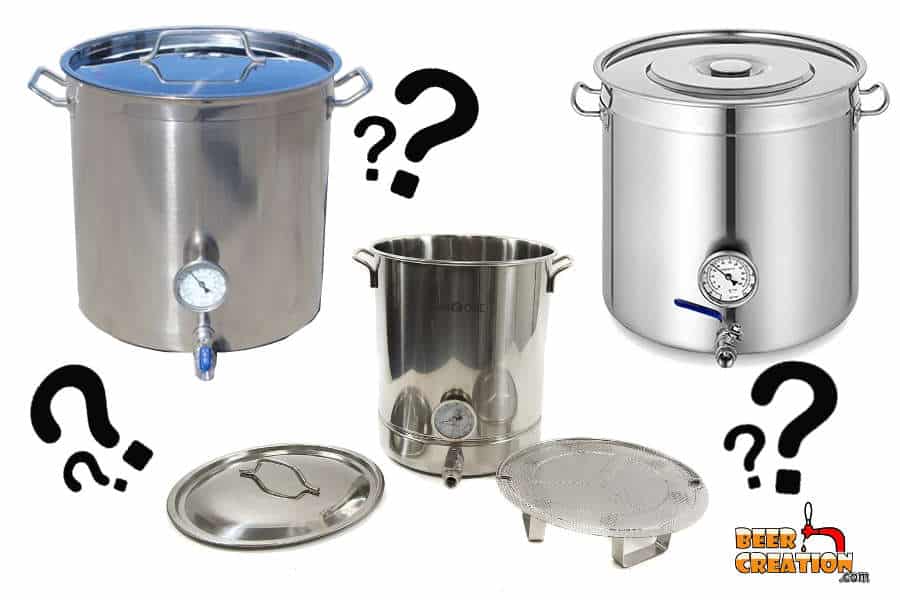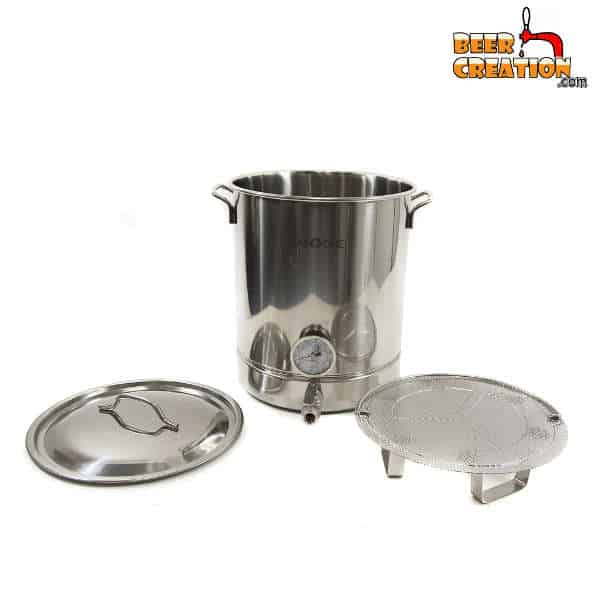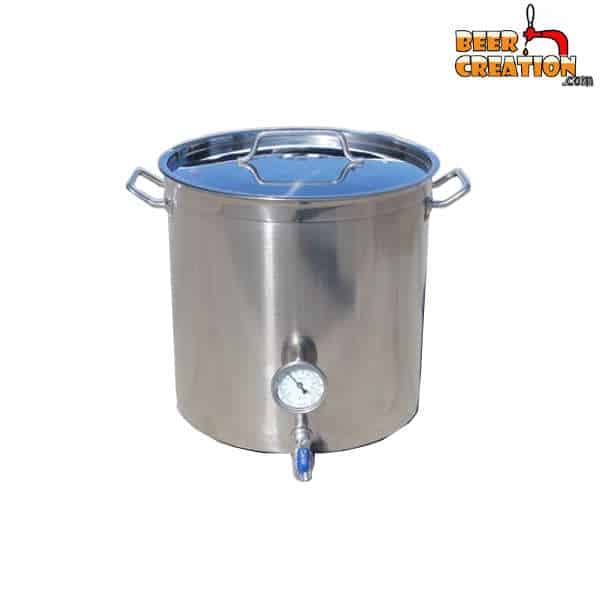Most brewers, and myself included, started their illustrious brewing careers with a simple starter beer making kit. You normally get everything you need in terms of ingredients and brewing equipment with one key exception, the pot you brew in!
Of course, I’m only talking about the sort of kits that cost less than about a hundred bucks and are designed to give you your first addictive taste of brewing. If you were lucky enough to land on your feet and get something like the Northern Brewer Homebrewing Starter Set 5-gallon Kit from Amazon, then you got everything you need. If this isn’t you, then read on to find out more about the size of the vessel you should be brewing in.
So, for the average first brew day what size pot do you need?
For the common 5-gallon extract beer-making recipe you will need a stockpot or vessel which can hold between 8-10 gallons of liquid. During boiling, around 1.5 gallons of wort will evapourate & adequate space to prevent a boil over is also needed. For all-grain brewing, additional pots are required.
So there you have it, the minimum size stockpot or brew kettle you need is around 8 gallons in capacity. However, there is more to choosing a good brewing pot than the size.
In this article, I’m going to evaluate everything you need to know when purchasing and using a pot for brewing beer. Stick around because this could save you both money and a lot of headaches in the future!
Size of brew kettle based on batch yield

Below is a quick reference to the minimum capacity you need for a brew kettle or mash tun based on a batch’s final yield of beer. Consider that you need at least 1.5 additional gallons in your boil to account for loss through evaporation and also at least 1 gallon of headspace in the boil to deal with the worrying to boil over.
Brew Yield | Brew Kettle |
1 gallon | 3.5 gallon |
5 gallons | 7 .5 gallon |
10 gallons | 12.5 gallon |
For mashing, you need roughly 1 to 1.5 quarts of water per pound of grain (2.1to 3.1 liters/kg). So, you will need to know your total grain bill in order to accurately calculate this.
Terms for different vessels used in brewing
Ok, so I’ve been using the word ‘pot’ too much so far and I want to move over to using some more common brewing terms. So, let me give you the rundown of all the different types of vessels and containers which are used in brewing so that we are on the same page.
Mash Tun: this is an isothermic vessel that is used to convert starches present in malted grains into fermentable sugars. It usually comes with a built-in false bottom for filtration and a handy spigot for draining off the wort. You only need this is if you are working with raw grains in an all-grain recipe. Check out my full article on everything you need to know about mash tuns.
Lauter Tun: this is something which is often confused with a mash tun as they are almost the same thing and in fact, a mash tun can also double up as part of a lautering system. In short, this is a vessel that is used to help rinse sugars out of the grain used in mashing at the end of that process. The system normally comes with another container called a hot liquor tank for storing hot sparge water.
Boil Kettle: this is probably what you are thinking when you were searching for the right size ‘pot’ for brewing. The boil kettle is, you’ve guessed it, where something is boiled. In this case, it’s the wort that is created either by mixing water with an a dry or liquid malt extract or directly from the mashing process in an all-grain brew day. In addition to the wort, hops are also boiled in the boil kettle. (shop for your hops online at homebrewing.org).
Fermenter/carboy: this is the vessel, often glass or plastic, where the magic really happens. After boiling and then cooling the wort, you transfer it to this container where you add yeast to start making beer. My favorite part!
How many pots do you need for brewing?
What equipment you need really depends on the type of recipe you are following. As I said before, if you have been given or bought a starter brewing kit you should have most of the brewing kit already with the exception of the brew kettle. This being said, extract brewing requires fewer containers than all-grain brewing.
If you are working with an extract kit then you can go directly to preparing your wort for the boiling stage all in the same vessel. You just have to mix the malt extract you’ve been given in the kit, either LME or DME, with enough water to account for loss through evaporation.
Once you have boiled your wort you can then allow it to cool or actively cool it down in the same brew kettle you’ve been using all along. Then you just need to transfer the cooled wort into the fermenter or carboy which came with your kit. So, for extract brewing, you don’t need much more than one pot acting as your brew kettle.
For All-grain brewing, however, you will need some more containers to make life easier. Here you are going to have to deal with mashing your grain and then lautering it. Although many brewers only attempt all-grain brewing after getting a few extract kit brew days under their belt, there are plenty of starter kits that are all-grain based.
So, here you will need at least one pot large enough to mash your grains in the strike water (usually 2-4 gallons depending on the recipe), a brew kettle with a 8-10 gallon capacity to accommodate a 1-5 gallon beer yield (depending on the recipe again) with 1.5 gallons extra wort during the boil, and another two vessels for lautering.
When it comes to lautering, or rinsing, your mashed wort you only need two specially designed containers, a lautering tun, and a hot liquor tank. However, if it’s your first ever attempt at brewing and you’ve unwittingly landed a recipe where you need to mash the grains, a lautering system might not be at hand.
In this case, you’re going to need to improvise. So, ideally you’ll need a pot to mash your grains with a capacity of at least 5 gallons for a normal batch, then you need another pot with the same capacity (although you may not need all 5 gallons worth) and another pot to act as your brew kettle with at least your target boil quantity (final yield + around 1.5 gallons) plus a bit of headspace to stop it boiling over. So, for a DIY all-grain brew day using conventional pots, having at least three containers to hand will come in very useful.
What’s the practical difference between a 5-gallon, 8-gallon, and 15-gallon brew kettle?
When it comes to different size brew kettles, it’s not only the capacity that you need to consider but also some practical differences on brew day.
Right now you may just be beginning your journey as a brewer, so you may want to only invest in something which you think you need right now. What I mean to say is if you are brewing 5-gallon kits it makes sense to only buy a brew kettle that accommodates these types of yields, right?
Cost
Well, the thing is, even though it’ll cost you more money and may see overkill for what you are brewing right now, it might be better, in the long run, to get yourself a whopping 15-gallon brew kettle from the start. Most brewers continue the hobby and go on to brew larger batches, so why buy two-piece of kit when you can use one over the course of your career as a brewer.
Boiling
However, It’s important to remember that a larger capacity kettle requires a lot more energy to heat and maintain temperature. So, if you are working with a brew kettle with an 8-gallon capacity or more then be aware that your stovetop may not be up to the job of boiling it up!
Weight
The sheer capacity, weight and surface area of a large brew kettle calls for a heat source with a bit more bite. So, when you increase your yields you will probably have to invest in a decent propane burner and more your boil out of the comfort of your kitchen.
Another thing to consider is that water, and therefore wort is heavy. 5 gallons of water weighs around 41.7 pounds (18.9 kg), which is already quite a load to lift. 8 or 15 gallons of wort is just impractical to move around comfortably.
So, when you upgrade your yields you need to also plan your brewing space more intelligently taking full advantage of gravity. Makes sure that you don’t end up enjoying your first beer of the batch from a hospital bed!
Choosing the right metal for your brewing pots.
When it comes to brew kettles, there most common choices are aluminum or stainless steel. Both options are fine but stainless steel seems to be more popular, but perhaps not for the right reasons.
Whereas stainless steel is certainly much more hard-wearing and has a feeling of ‘cleanliness’ about it, it’s not as good at conducting heat as aluminum nor does it cool down as quickly, which is ideal if you don’t have a wort chiller in your brewing arsenal.
While it’s also true that aluminum is cheaper than stainless steel, many brewers pay the higher fees for it as it is easier to clean with oxygen-based cleaners. Aluminum will oxidize when these types of caustic cleaners.
What’s the best pot to buy
Below are just some suggestions for brew kettles you could buy right now for your next brew day. Each one depends on your personal budget and brewing needs.
GasOne 10 gallon (Stainless Steel)

This brew kettle is a little more of an investment but comes with a very good inbuilt bazooka screen for the spigot as well as a false bottom which means it can double up as a mash tun. The same model is currently being sold on Amazon with an 8, 10 and 16-gallon capacity. Check for the best prices right now.
Concord 10 gallon (Stainless Steel)

This brew kettle is a good low budget option, although it’s still going to be a few bucks to buy. It comes with a thermometer that’s already plumbed in as well as a handy spigot. The same company makes pots with a capacity from 5 to 45 gallons, but 10 should see you right for most brews. See the current prices and availability over on Amazon.
Mophorn 25 gallon (Stainless Steel)

This is a good basic brew kettle which has a very useful thermometer already attached to the pot as well as a spigot for easily transferring your wort out of the kettle. The Morphorn model comes in many sizes from 8 gallons right up to 45 gallons. Here I suggest getting the 25-gallon model if you are looking for a larger pot as it’s great value! Get the right sized pot for you on Amazon and has it delivered in the next few days or sooner with prime membership.
Related Questions
What size pot do I need for BIAB brewing?
The Brew In A Bag technique is designed to make brewing a little less labor-intensive by eliminating the need to lauter your all-grain brew in a separate container. Basically you should be able to mash your grains in their bag in the same container that you then boil the wort in once the grain has been removed.
However, sometimes sparging is necessary even for the BIAB approach. If you want to check out my article on this topic, click here.
So, when considering what size container you need for your BIAB brew day, you need to treat your mash tun as if it were your boil kettle. This is to say, if you are brewing, say, 5 gallons of beer you need to start with a brew kettle large enough to accommodate at least 7-8 gallons of liquid even if you don’t start off the mash with this amount.





